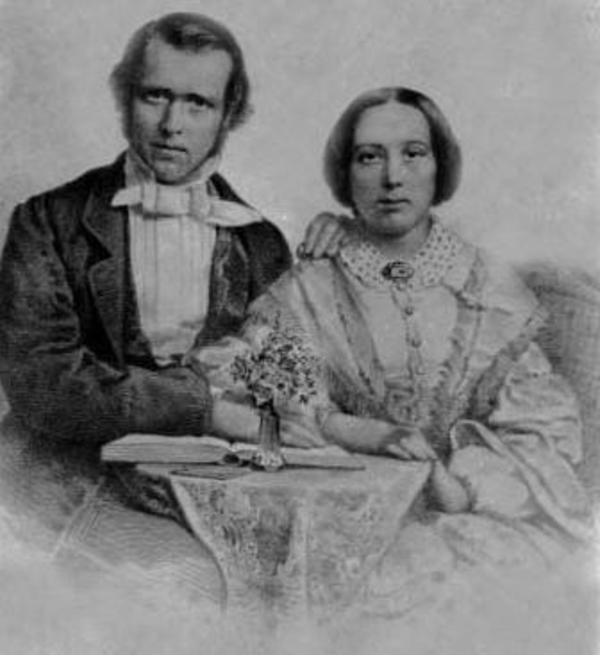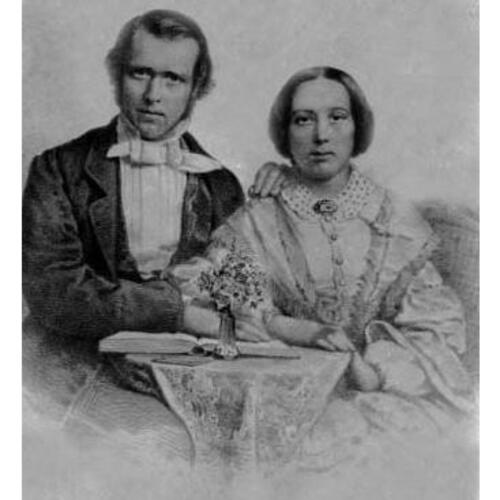
Source: Link
GORDON, GEORGE NICOL, Presbyterian clergyman and missionary; b. 21 April 1822 at Cascumpeque (Alberton), P.E.I., son of John Gordon and Mary Ramsey; d. 20 May 1861, at Eromanga, New Hebrides.
In 1786 George Nicol Gordon’s father had come to Prince Edward Island with his parents from Scotland via Shelburne, N.S. In 1813 John Gordon and his family became tenants on the estate of Samuel Cunard, whose alleged unfair practices as landlord they fought for many years; in 1850 they were forcibly evicted. George Gordon was able to get only limited schooling in the area and then worked on his father’s farm and as a tanner.
In 1848 Gordon underwent a deeply moving religious experience, and in 1850, at age 28, he enrolled in the academy attached to the Presbyterian Free Church College in Halifax, N.S. The following year he studied briefly at the Presbyterian Church’s Theological Hall at West River, Pictou County, N.S., and then returned to Halifax where he began regular studies at the Free Church College. While studying he was instrumental in securing in 1852 the establishment of the Halifax City Mission and became its first missionary. The next year he offered himself as a foreign missionary to the Board of Foreign Missions of the Free Church Synod of Nova Scotia and was accepted for service in the New Hebrides in the South Pacific. By the spring of 1854 he had completed his formal studies. In 1855 he undertook a missionary preaching tour of Prince Edward Island, was ordained that September in Pictou, and soon thereafter left for London, England, to study medicine. It was in London that he met Ellen Catherine Powell, who was prepared to become a missionary’s wife despite rather frail health. They were married in June 1856.
The Gordons set out from London for the New Hebrides on the London Missionary Society’s vessel, John Williams, at the end of July 1856. In June 1857 they reached Aneityum, where John Geddie* of Nova Scotia had maintained a virtually solitary but highly successful Presbyterian mission since 1848. Finally, on about 15 June 1857, the Gordons landed at Dillon’s Bay on the island of Eromanga. There the pioneer missionary of the society, John Williams, had been killed in 1839, and the society had subsequently sent Samoan and Rarotongan teachers to prepare the way for a European missionary. During the 1840s and 1850s Eromanga had often been visited by sandalwood traders, chiefly from Sydney, New South Wales; by 1857 there were several permanent trading stations, including at least one at Dillon’s Bay, not far from the site chosen for the mission settlement.
During their four years in Eromanga the Gordons endured many hardships, especially Mrs Gordon’s frequent attacks of malaria which eventually necessitated the removal of the mission house to a healthier location on a nearby hill. Gordon was a powerful, energetic man, and as a skilled tradesman was particularly well qualified for the physical labour of early missionary work. With only a few native helpers he built a house, a church, and other buildings. Ten weeks after his arrival he had translated the Ten Commandments into the Eromangan dialect of Melanesian, and later translated and personally printed many other religious and educational works, including scriptural passages. He held regular services, ran a school at Dillon’s Bay, and often visited other parts of the island. Gordon wrote occasionally for the Presbyterian Witness of Halifax, edited by his friend the Reverend Robert Murray*, and for the London Missionary Register. By 1861 he had won a small number of adherents on the island, who had renounced the traditional practices which the Gordons found objectionable, wore clothes, attended classes and services, and observed the Sabbath. Gordon was at first unconvinced of the value of native teachers in pioneer missionary work, and for a long time refused to train a body of local helpers. This refusal limited the range of his influence and effectiveness, and probably contributed to the misunderstandings which were to result in the Gordons’ deaths.
In January 1861 a trading vessel brought people infected with measles to Dillon’s Bay. The Eromangans ignored Gordon’s warning to avoid contact with the ship, and the disease, complicated by dysentery, spread rapidly throughout the island. Many deaths and great misery followed. At about the same time a series of cyclones devastated crops and threatened famine for the survivors of the epidemic. By dispensing medicine and caring for the sick, Gordon tried to mitigate the effects of the disaster. Traditionally, Eromangans believed that disease, death, and natural disaster always resulted from sorcerers’ magic, and suspicion of sorcery immediately fell upon Gordon, who had predicted the ravages of the epidemic and who seemed immune to its effects.
In mid May Gordon’s local assistants warned him to move his household back to the coast and the protection of friendly islanders. He refused. On 20 May 1861 he was ambushed at work and murdered by a group of nine Eromangans. One of the assassins then killed Mrs Gordon with his hatchet at the door of the mission house. She and her husband were both to be described as “martyrs” by Gordon’s younger brother, James Douglas*, later also killed on Eromanga. His The last martyrs of Eromanga . . . , attributed their deaths to the malicious influence of sandalwood traders. Several traders who were hostile to the missionaries seem indeed to have fanned the anger of some Eromangans against Gordon and his God. Gordon’s own actions, however, appear to have been at least as important. He wrote in his diary: “[The disease] was preceded by nearly a universal opposition to the gospel, and much murder and idolatry. I felt sure that God would visit them in judgment and warned them most solemnly but a few days before they were attacked. The chiefs . . . can hardly persuade their people that this is not the finger of Jehovah.” In a long letter published in the Evangelical Christendom of London on 6 April 1861, he emphasized the severity of the epidemic of measles, the growing tension, and the recent great “wickedness of this people.” Gordon’s tragedy was that the islanders regarded him as the means by which divine retribution was called down upon them. Geddie, an experienced missionary, questioned the “propriety and prudence of denouncing temporal judgment,” and considered that Gordon’s words had certainly contributed to the suspicions against him.
Gordon was a dedicated and devoted missionary, but his limited success on Eromanga resulted at least in part from a lack of judgement which coincided with his more admirable qualities. Thus courage and independence led him to eschew native help in proselytism and to ignore warnings about the dangers he faced; his fervent commitment to his religion led him publicly to denounce traditional attitudes and behavior, with fatal results.
J. D. Gordon, The last martyrs of Eromanga: being a memoir of the Rev. George N. Gordon and Ellen Catherine Powell, his wife (Halifax, 1863); [ ], The sandalwood trade and traders of Polynesia (Halifax, 1862). Evangelical Christendom (London), 6 April 1861. Presbyterian Church of the Lower Provinces of British North America, Home and Foreign Record (Halifax), I (1861). Presbyterian Witness, 5, 21 Oct., 7 Dec. 1861. Reformed Presbyterian Magazine (Edinburgh), October 1861. Samoan Reporter (Leulumoega, Samoa), May 1862. George Patterson, Missionary life among the cannibals: being the life of the Rev. John Geddie, D.D., first missionary to the New Hebrides; with a history of the Nova Scotia Presbyterian mission on that group (Toronto, 1882). H. A. Robertson, Erromanga, the martyr isle, ed. John Fraser (London, 1902). Robert Steel, The New Hebrides and Christian missions, with a sketch of the labour traffic, and notes of a cruise through the group in the mission vessel (London, 1880).
Cite This Article
Bronwen Douglas and Bruce W. Hodgins, “GORDON, GEORGE NICOL,” in Dictionary of Canadian Biography, vol. 9, University of Toronto/Université Laval, 2003–, accessed December 24, 2025, https://www.biographi.ca/en/bio/gordon_george_nicol_9E.html.
The citation above shows the format for footnotes and endnotes according to the Chicago manual of style (16th edition). Information to be used in other citation formats:
| Permalink: | https://www.biographi.ca/en/bio/gordon_george_nicol_9E.html |
| Author of Article: | Bronwen Douglas and Bruce W. Hodgins |
| Title of Article: | GORDON, GEORGE NICOL |
| Publication Name: | Dictionary of Canadian Biography, vol. 9 |
| Publisher: | University of Toronto/Université Laval |
| Year of publication: | 1976 |
| Year of revision: | 1976 |
| Access Date: | December 24, 2025 |



